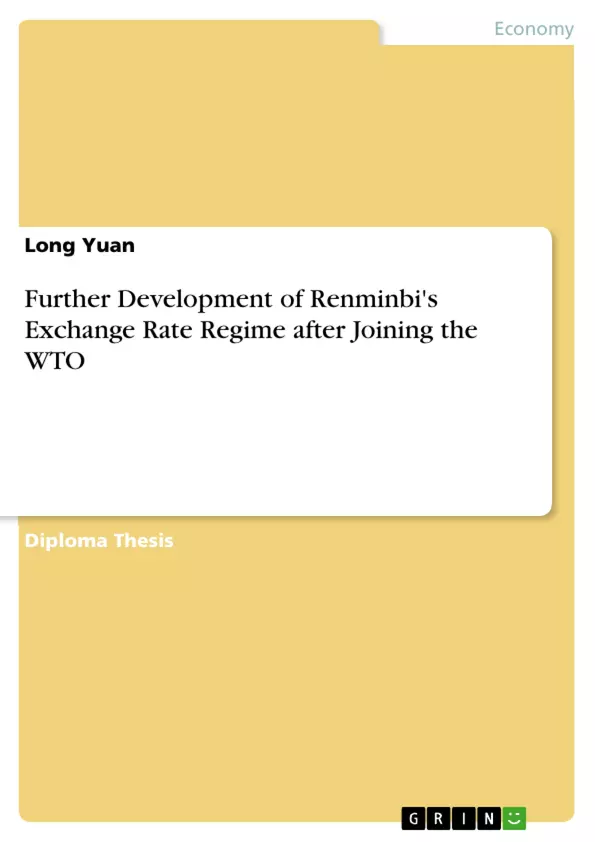Since 2002, China‘s rapid growth and the trend of globalization have forced China to face its currency‘s regime development. Although Chinese central bank in 2005 announced to adjust its regime towards basket policy, Yuan has been pegged to USD while maintained undervalu-ation and trade surplus in the following years, which led to global criticism and pressure to revalue. Under such circumstance, the discussion around Yuan has shifted towards whether Chinese currency regime should be more flexible, abandoning the old argument that how much Yuan should revalue.
This essay provides a study regarding the future of RMB, based on analysis of Yuan‘s development before and after entering WTO, and the pros and cons of Yuan‘s regime during China‘s development. Also, this article also draws insights from the development of capital export and restriction, high saving rate and huge foreign reserves. Based on the analysis, the article reaches the conclusion: considering the huge negative impact on China‘s economy should Yuan revaluate, it is not realistic to expect Yuan to raise sharply in the near future; if China is to allow Yuan to revalue, the most possible course of action is to implement some extra financial polices to reduce the impact.
Inhaltsverzeichnis (Table of Contents)
- 1. Introduction
- 2. Literature Review
- 2.1 De Jure Classification and De Facto Classification
- 2.2 Exchange Rate Regimes: Classification and Characteristics
- 3. Historical Development of the Chinese Exchange Rate Regime before Joining the WTO
- 3.1 A Fixed Exchange Rate with the Unilateral RMB Peg to the U.S. Dollar
- 3.1.1 A Brief History of Chinese Currency Exchange Regime
- 3.1.2 The Pros and Cons of Chinese Currency Exchange Policy
- 3.2 China's Exports of Capital and Capital Account Controls before Joining the WTO
- 3.2.1 The Capital Exports of China before Entering WTO
- 3.2.2 The Capital Control Strategy of China before Entering WTO
- 3.3 Overvaluation and Undervaluation of RMB
- 3.1 A Fixed Exchange Rate with the Unilateral RMB Peg to the U.S. Dollar
- 4. More Developments of RMB's Exchange Rate Regime after Joining the WTO
- 4.1 The Change in Chinese Exchange Rate Regime after Entering WTO
- 4.2 The Status Quo of China's Capital Account Liberalization
- 4.2.1 Capital Management Policy of China after Entering WTO
- 4.2.2 The Reason behind China's Capital Restriction
- 4.3 China's high Saving Rate and Large Foreign Reserves
- 4.3.1 High Saving Rate: China's Modern Characteristic
- 4.3.2 China's Foreign Reserve
- 4.4 The Goal and Strategy of RMB
- 4.4.1 The Goal of Chinese Exchange Regime
- 4.4.2 Should Yuan Revaluate?
- 4.4.3 RMB's Strategy
Zielsetzung und Themenschwerpunkte (Objectives and Key Themes)
This essay provides a comprehensive analysis of the Renminbi's exchange rate regime, focusing on its development before and after China's entry into the World Trade Organization (WTO). The study aims to explore the advantages and disadvantages of the Yuan's regime throughout China's economic growth, considering factors such as capital export and restrictions, high savings rates, and substantial foreign reserves. Through this analysis, the essay seeks to understand the future of the RMB and its potential trajectory.
- The evolution of the Chinese exchange rate regime before and after joining the WTO.
- The pros and cons of the Yuan's exchange rate regime during China's economic development.
- The impact of capital export and restrictions, high savings rates, and foreign reserves on the RMB.
- The potential implications of Yuan revaluation on China's economy.
- The future direction of the Renminbi's exchange rate regime.
Zusammenfassung der Kapitel (Chapter Summaries)
The first chapter introduces the topic of the Renminbi's exchange rate regime and provides an overview of the essay's objectives. The second chapter reviews relevant literature on exchange rate regimes, their classifications, and characteristics. Chapter three delves into the historical development of the Chinese exchange rate regime prior to China's WTO entry, examining the fixed exchange rate with the unilateral RMB peg to the U.S. dollar, capital export and controls, and the overvaluation and undervaluation of the RMB. Chapter four explores the further development of the RMB's exchange rate regime after China's WTO accession, including the change in regime, the status quo of capital account liberalization, China's high saving rate and foreign reserves, and the goal and strategy of the RMB.
Schlüsselwörter (Keywords)
This study focuses on China's exchange rate regime, the Renminbi (RMB), and its undervaluation. Key concepts include capital controls, foreign exchange reserves, high savings rates, and Yuan revaluation. The study draws on analysis of the RMB's historical development, particularly its trajectory before and after China's WTO accession.
- Quote paper
- Long Yuan (Author), 2010, Further Development of Renminbi's Exchange Rate Regime after Joining the WTO, Munich, GRIN Verlag, https://www.grin.com/document/165078



